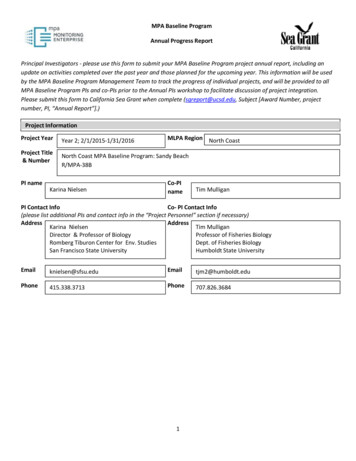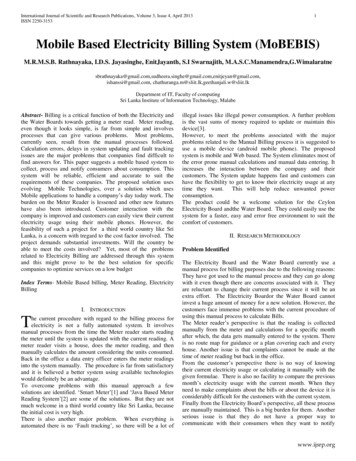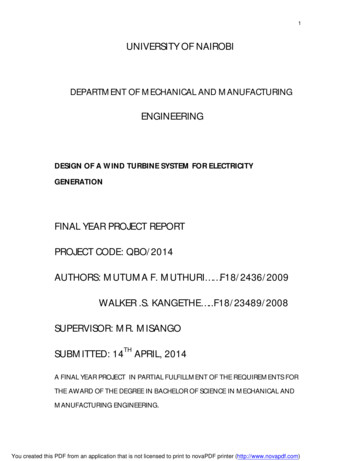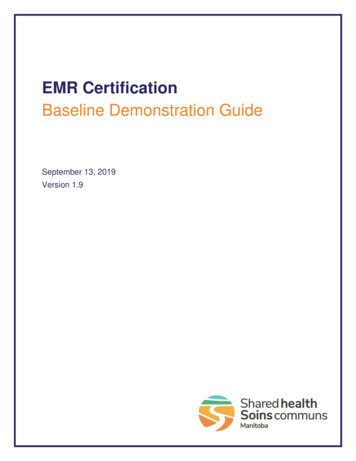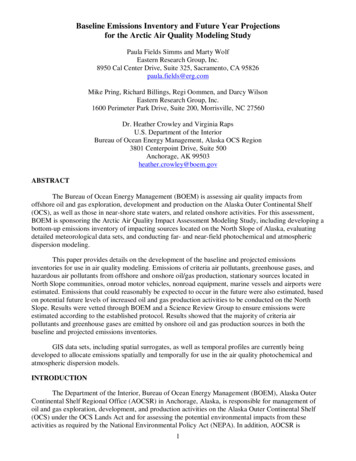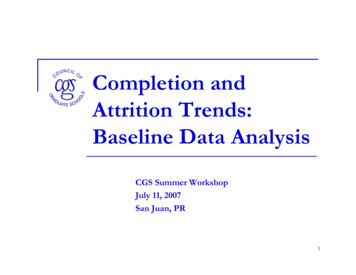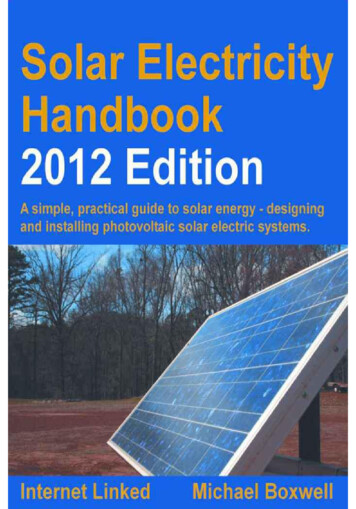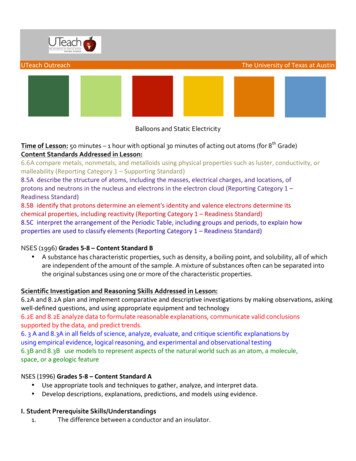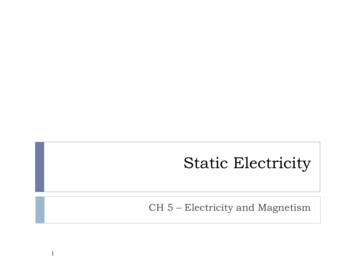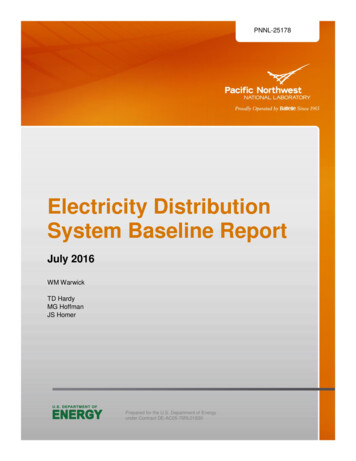
Transcription
PNNL-25178Electricity DistributionSystem Baseline ReportJuly 2016WM WarwickTD HardyMG HoffmanJS HomerPrepared for the U.S. Department of Energyunder Contract DE-AC05-76RL01830
This report is a DOE EPSA product and part of a series of “baseline” reports intended to inform thesecond installment of the Quadrennial Energy Review (QER 1.2). QER 1.2 will provide a comprehensivereview of the nation’s electricity system and covers the current state and key trends related to theelectricity system, including generation, transmission, distribution, grid operations and planning, and enduse. The baseline reports provide an overview of elements of the electricity system.To help understand how the energy systems might develop into the future under Business as Usual (BAU)conditions QER 1.1 relied upon the U.S. Energy Information Administration’s Annual Energy Outlook(AEO) 2014 Reference Case. EPSA could not rely completely upon AEO for QER 1.2 as AEO 2016 wasnot completed and AEO 2015 did not include the Clean Power Plan. So the EPSA Base Case wasdeveloped and it aligns as closely as possible with AEO 2016 given the timing issues.The EPSA Base Case scenario was constructed using EPSA-NEMSa, a version of the same integratedenergy system model used by EIA. The EPSA Base Case input assumptions were based mainly on the finalrelease of AEO 2015, with a few exceptions as noted below, and then updated to include the Clean PowerPlan and tax extenders. As with the AEO, the ESPA Base Case provides one possible scenario of basecase energy sector demand, generation, and emissions from present day to 2040, and it does not includefuture policies that might be passed or future technological progress.The EPSA Base Case input assumptions were based mainly on the final release of the AEO 2015, with afew updates that reflect current technology cost and performance estimates, policies, and measures.Assumptions from the EIA 2015 High Oil and Gas Resources Case were used; it has lower gas pricessimilar to those in AEO 2016. The EPSA Base Case achieves the broad emission reductions required bythe Clean Power Plan. While states will ultimately decide how to comply with the Clean Power Plan, theEPSA Base Case assumes that states choose the mass-based state goal approach with new sourcecomplement and assumes national emission trading among the states, but does not model the CleanEnergy Incentive Program because it is not yet finalized. The EPSA Base Case also includes the taxcredit extensions for solar and wind passed in December 2015. In addition, the utility-scale solar andwind renewable cost and performance estimates have been updated to be consistent with EIA’s AEO2016. Carbon capture and storage (CCS) cost and performance estimates have also been updated to beconsistent with the latest published information from the National Energy Technologies Laboratory. AnEPSA Side Case was also completed, which has higher gas prices similar to those in the AEO 2015Reference Case.aThe version of the National Energy Modeling System (NEMS) used for the QER base case has been runby OnLocation, Inc., with input assumptions by EPSA. It uses a version of NEMS that differs from the oneused by the U.S. Energy Information Administration (EIA), the model is referred to as EPSA-NEMS.
[This page intentionally left blank]
Electricity Distribution SystemBaseline ReportWM WarwickTD HardyMG HoffmanJS HomerJuly 2016Prepared forthe U.S. Department of Energyunder Contract DE-AC05-76RL01830Pacific Northwest National LaboratoryRichland, Washington 99352
Executive SummaryThis Electricity Distribution Baseline describes current practices, emerging trends, and nationalimplications of an evolving electricity distribution sector in the United States. It is organized intotwo parts.The first section, The Legacy of the 20th Century Utility, provides an overview of the history andcurrent state of the distribution sector. Topics covered in this section include the following: The history of the regulatory compact An overview of utility types and their characteristics A summary of ratemaking and regulatory oversight Engineering descriptions of key components of the system A discussion of distribution system operations An overview of distribution system planning.The second section, Toward a 21st Century Utility, discusses emerging issues related toadvanced grid technologies, the integration of distributed energy resources, and the evolvingexpectations for utilities. Topics covered in this section include the following: An overview of advanced grid technologies Measures of advanced grid technology proliferation across utility types Microgrids Emerging regulatory practices Jurisdictional issues.Below are key findings that emerge from this comprehensive overview of distribution systemsgrouped by theme.Distributed Energy Resource (DER) System Integration DERb deployment is growing rapidly and is forecasted to increase over time. Traditionaldistribution system functions and physical architectures that enable passive one-wayelectricity delivery from central power plants to end-use customers are unlikely to beadequate for a high-DER future. Distribution utilities will need new approaches for systemoperation, grid planning, interconnection procedures, and coordination with transmissionsystem and wholesale markets to handle forecasted increases in DER penetration.The U.S. Department of Energy defines distributed energy resources as, “ a range of smaller-scale and modulardevices designed to provide electricity, and sometimes also thermal energy, in locations close to consumers. Theyinclude fossil and renewable energy technologies (e.g., photovoltaic arrays, wind turbines, microturbines,reciprocating engines, fuel cells, combustion turbines, and steam turbines); energy storage devices (e.g., batteriesand flywheels); and combined heat and power systems.” Source: t/smart-grid/distributed-energy.biii
Proliferation of distributed generation (DG)c and home area networks (HANs) has beenlargely driven by customer choice, which is in turn influenced by state and local policies,utility rate design, and technology cost-effectiveness. Some consumer-focused DERs, likesmart thermostats and Internet-connected electric vehicle-charging infrastructure thatconstitute HANs, allow a more hands-off approach to energy management and greaterresponse to dynamic price signals than what was once available. The automated nature ofthese devices lowers barriers for sustained household participation in demand responseprograms and dynamic pricing structures. According to one study, rural cooperatives and municipal utilities, which together serveroughly 30 percent of the nation’s customers, are less likely to have distribution managementsystem (DMS) equipment in place, thereby increasing their incremental DER integrationcosts relative to investor-owned utilities (IOUs), which tend to be larger. Higher incrementalcosts threaten to inhibit adoption of advanced grid technologies thereby excluding some,largely rural, customers from full participation in advanced grid technologies, in turn raisingpotential ratepayer equity concerns.Proliferation of Advanced Grid Technologies Utility adoption and use of advanced grid technologies—including physical components,grid-monitoring software, and grid-management tools—vary by utility type and size. IOUsreported investment in significantly more advanced grid technologies than municipal andcooperative utilities, which are usually much smaller than IOUs. Municipal utilities are morelikely than cooperatives to have implemented advanced grid technologies. The lesser degreeof investment by municipal and cooperative utilities suggests that there may be significantbarriers to their adoption and/or that the net benefits of these new technologies are not [yet]applicable to municipal and cooperative utilities’ system characteristics. No matter the cause,the lag in advanced grid technology implementation could cause persistent differences incustomer access to DER and total system costs between IOUs, which are usually large andserve urban customers, and municipal and cooperative utilities, which are usually smaller andserve rural customers. There is still a need, however, for more analysis to understand barriersand implications for the lack of small utility adoption of advanced grid technologies. Utilities have installed various advanced grid management systems, though these systems arerarely integrated with one another, potentially limiting their full contribution of systembenefits. One survey of utility professionals found that data management, analysis,application, and integration of both systems and data from disparate systems is their greatestchallenge to utility management. A foundational technology to enable the grid of the future is Supervisory Control and DataAcquisition (SCADA). SCADA extends beyond the distribution substation to providesituational awareness of distribution system status, automation of critical distribution systemmanagement components, and a communications system that can interact with individualcustomers and their grid-connected end uses. When distribution-level SCADA pairs with aDMS, formerly manual operations can be conducted remotely, increasing the speed at whichcDistributed generation excludes distributed energy resources that apply to demand reduction but do not generateenergy.iv
a utility can identify and locate faults on the distribution system and restore service as well asmanage voltage and reactive power to reduce energy losses and integrate distributedgeneration and storage technologies. Maximizing the value of DER will likely require theintegration of advanced grid software and hardware; utility challenges with integration mayprove to be a barrier for efficient proliferation of DER.Risk and Regulatory Approval of Advanced Grid Technologies Costs of advanced grid technologies, weighed against uncertain financial benefits for utilitiesand their customers, have stymied utility investment. The impasse stems from utilities’concern about the likelihood of obtaining regulatory approval of advanced grid technologies,costs, and regulators’ concern that costs to consumers may not be commensurate with theirbenefits. Utility estimates suggest that initial DER integration costs will largely be for enablinginfrastructure—such as two-way communication and control systems, metering, and safetyequipment—which is unlikely to provide an immediate financial benefit to offset the initialcosts. Use of uniform equipment and standard design criteria has lowered utility costs and enabledrapid restoration of service; they have also made it harder to implementing non-uniform partsand procedures in utility systems. Performance risk, or the risk that the product will notperform as expected, is greater for advanced grid components and systems than forcomparable traditional assets. Stranded costs and risks associated with rapid obsolescence of advanced technology havepresented barriers to utilities’ and regulators’ acceptance of new technologies. Several policyand regulatory options have come into existence to mitigate risk associated with rapidobsolescence of advanced grid technologies. Proliferation of these policy and regulatorymeasures could facilitate utility adoption of advanced grid technologies.Distribution System Planning and Analysis Tools that utilities use for long-term resource planning, short-term power management,transmission planning and operations, distribution planning and monitoring, revenueforecasting, and rate setting are purpose-specific and generally not integrated with oneanother. This lack of integrated-analysis tools complicates the integration of advanced gridtechnologies. The complexity and costliness of integrated systems modeling tools maystymie utility-by-utility development; the industry may benefit from flexible and specifiableshared modeling resources.Distribution System Efficiency While the U.S. electric transmission and distribution system is among the most efficient inthe world, roughly 6 percent of total generated electricity is lost in the system. One of the largest sources of loss is distribution transformers, which contribute roughly athird of total losses, or 2 percent of all generated electricity in the United States. Howeverv
new federal efficiency standards are expected to reduce these losses significantly, saving 3.6quads of energy over 30 years. Further efficiency improvements are possible with both upgrades to more efficient equipmentas well as new technologies that allow for the more efficient management of power flows toreduce losses. No one has undertaken a comprehensive, national study of the economic potential forefficiency upgrades in the U.S. distribution system. Studies of loss-reduction potential forspecific technologies have estimated what losses each technology could reduce; however,these studies predominantly focus on the technical potential of either full deployment of atechnology or optimizing operations to minimize losses. These results are likely to overstatethe potential for loss reduction when improvements must also be subject to cost-benefit testsor other network-specific operational constraints. Replacing existing infrastructure for loss-reduction purposes alone is typically not justifiableon economic grounds. However, there can be positive net benefits for incorporating lossreduction considerations into the design or planning of new capacity or reliabilityinvestments being made for other reasons. Efforts to invest in cost-effective efficiency improvements are likely further constrained inpart by regulatory policies that do not allow recovery of the cost of the full capture ofefficiency benefits by the operators who would incur the costs. For example, most states thatrequire utilities to meet energy efficiency resource standards allow only end-use effic
distribution system functions and physical architectures that enable passive one-way electricity delivery from central power plants to end-use customers are unlikely to be adequate for a high-DER future. Distribution utilities will need new approaches for system operation, grid planning, interconnection procedures, and coordination with transmission system and wholesale markets to handle .
